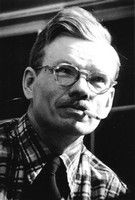Kenneth Stubbs |
 |
|
American painting between the 1930s and 1960s is, according to most standard art historical accounts, two distinct eras separated by World War II. This exhibition in examining the career of Kenneth Stubbs, 1907-1967, presents us with a welcome opportunity to look beyond the by now conventional view that opposes modern and contemporary, and beings instead taking fresh stock of this period as more of a whole and extended movement. This display reveals the building blocks, and back and forth interplay of concerns, all of which contributed to the consistency that marks the development of this intriguing artist's vision. This way of working was one that Stubbs seemed to share with other significant talents active during the second third of the 20th century. It appeared to have been predicated on the desire to answer a question that held a tremendous resonance in that period. The question was pondering out what to do with the legacies left by the relatively recent successive avantgarde waves of impressionism, postimpressionism and cubism, as well as centuries of academic tradition. De Koonig wrestled with this. Milton Avery did. Like Stubbs, each was incredibly single-minded about following the aesthetic path their answers produced. Given the open-ended character of the question and its answers, where to focus was key. Stubbs' solution was to let his innate leaning toward analysis and composition be his guide. Starting with the painting he did during the 1930s, he launched the rigorous process of sorting through the extensive education in old and avantgarde masters he had received at the Corcoran School of Art in Washington, DC and E. A. Webster's School of Art in Provincetown. After returning in 1945 from navy service in World War II, he continued the investigation with renewed enthusiasm. Stubbs, who was born in Ochlocknee, Georgia and moved to Washington, DC with his family when he was a boy, first showed evidence in early childhood of his abiding interest in art. Except for a brief stint working in advertising art in Detroit and his war-time obligations, the nation's capital remained home to Stubbs, who also spent summers in Provincetown. From 1935 to 1953 he was an instructor of painting and drawing at the Corcoran School of Art, taught at George Washington University nearby, regularly showed in the Corcoran Biennial and with the Provincetown Art Association. The engaging Stubbs, with his independent views of art and art politics, typically was at the thick of things in both of these major centers. No doubt the same talent for applying systems involving a multiplicity of possibilities, which helped make him a leading tournament chess player and award-winning writer and planner of technical and animation films, also shaped his remarkably comprehensive approach to painting. In the 1935 portrait of a seated young woman, Stubbs has, in the arresting presence and solid design of the figure and her landscape surroundings, merged two of his major influences--early Italian Renaissance painter Piero della Francesca and French Post-impressionist Paul Cezanne. Of the Cubist artists, Pablo Picasso and Juan Gris were closely scrutinized by him. And Stubbs has located the stylistic underpinnings for the flat patterns and abstract shapes commanding our attention in Artist and Model, 1947, and Dancers, 1948, in Cubism's conceptualization of reality. This aspect of Cubism was reflected as well in the emphasis given in his painting to representing ideas about nature and life. From travels, literature, art history, everyday observations, Stubbs enjoyed treating a variety of subjects. Still Life with Martini, 1953, and Beach Ball, 1960, were other examples demonstrating how the complex relationships of form, line and color he was so adept at handling were used by Stubbs to create qualities of harmony of a kind deep and richly satisfying enough to refresh and replenish the spirit. Ronny Cohen © 1997
Permission to reproduce catalog for this website courtesy of Denise Bibro Fine Art, NYC. No further reproduction permitted without written consent from Denise Bibro Fine Art. |
See also: Announcement Exhibition Catalog Works Shown Installation Photos |